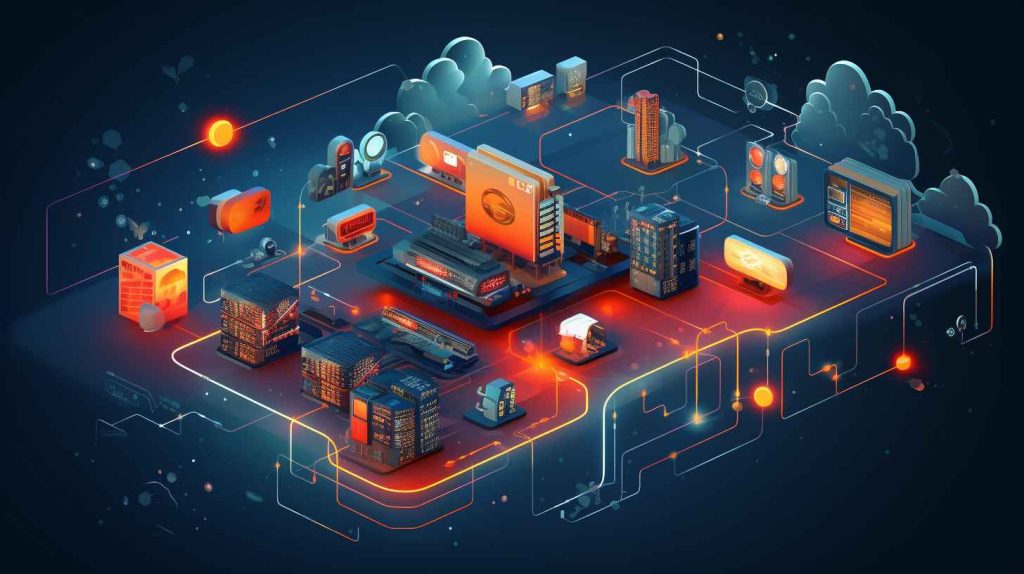Imagine a world where every device in your home seamlessly communicates and adapts to your needs. This is the promise of IoT, but its full potential can only be realized with the power of MLOps.
Just as a conductor orchestrates a symphony, MLOps serves as the maestro behind the scenes, harmonizing data, models, and operations to create a symphony of smart technology.
Statista predicts that worldwide spending on the Internet of Things (IoT) will hit a whopping 1.1 trillion US dollars in 2023. Moreover, they expect the number of active devices connected to the IoT to soar to 30.9 billion by 2025.
In this article, we will explore how mastering MLOps for IoT can revolutionize the deployment of smart technology, unlocking a new era of freedom and convenience.

Key Takeaways
– MLOps automates and streamlines the integration, deployment, management, and optimization of machine learning models in IoT systems.
– MLOps enables organizations to make data-driven decisions and derive valuable insights from IoT devices.
– MLOps improves IoT device performance by efficiently managing resources and reducing latency.
– Implementing MLOps in IoT requires seamless integration, collaboration, version control, automated testing, and optimized data processing pipelines.
The Intersection of MLOps and IoT
The intersection of MLOps and IoT is a fascinating area that holds immense potential for smart technology deployment.
To understand this intersection, it is crucial to first grasp the concept of IoT and its implications in various industries.
Additionally, exploring the role of MLOps in IoT can shed light on how machine learning operations can enhance the efficiency and effectiveness of IoT systems.
Understanding IoT and its Implications
An understanding of IoT and its implications is crucial for harnessing the potential of MLOps in the intersection of IoT and smart technology. IoT, or the Internet of Things, refers to the network of interconnected devices that collect and exchange data. Its implications are far-reaching, affecting various aspects of our lives. Here are some key points to consider:
Complexity
IoT involves managing a vast number of smart devices, each generating a significant amount of data. MLOps can help automate and streamline this process.
Use Case
MLOps can be applied in various IoT use cases, such as predictive maintenance, anomaly detection, and real-time monitoring.
Edge Device
IoT devices often operate at the edge, where computational power is limited. MLOps can optimize the deployment and management of AI models on these edge devices.
Automation
MLOps enables the automation of machine learning workflows, making it easier to develop, deploy, and maintain AI models for IoT applications.
The Role of MLOps in IoT
With the increasing adoption of IoT technology and the growing need for effective management of AI models, MLOps has emerged as a vital component in ensuring the successful integration and deployment of machine learning in IoT systems.
MLOps for IoT refers to the application of best practices and techniques to automate the process of integrating machine learning algorithms into the Internet of Things ecosystem. This involves not only deploying and managing machine learning models but also ensuring their continuous monitoring and optimization in real-time.
By leveraging MLOps, organizations can streamline the development and deployment of machine learning models, enabling them to make data-driven decisions and derive valuable insights from their IoT devices.
MLOps enables the seamless integration of machine learning capabilities into IoT systems, empowering businesses to unlock the full potential of their IoT data and drive innovation at scale.
Benefits of MLOps for IoT
Implementing MLOps in IoT systems brings several benefits.
Firstly, it enhances machine learning models by enabling continuous training and deployment, ensuring they stay up-to-date and perform optimally.
Secondly, it improves IoT device performance by efficiently managing resources and reducing latency, resulting in faster and more reliable operations.
Lastly, MLOps enables real-time decision making by automating the process of collecting, analyzing, and acting upon data, allowing organizations to respond quickly to changing conditions and make informed decisions.
Enhancing Machine Learning Models
Leveraging MLOps for IoT holds immense potential in optimizing machine learning models for enhanced performance and accuracy. By integrating MLOps into IoT edge devices, organizations can benefit from real-time data processing and analysis, enabling them to make informed decisions and take immediate actions.
Some of the benefits of MLOps for IoT include:
Improved model deployment:
MLOps helps streamline the deployment process of AI and ML models in IoT devices, ensuring faster and more efficient implementation.
Seamless cloud integration:
MLOps allows for easy integration with cloud platforms, enabling organizations to leverage the scalability and flexibility of the cloud for their IoT deployments.
Empowering data scientists:
MLOps provides data scientists with the tools and frameworks they need to efficiently develop, test, and deploy machine learning models in IoT environments.
Improving IoT Device Performance
To optimize IoT device performance, organizations can harness the benefits of MLOps by implementing efficient strategies and utilizing advanced analytics techniques. MLOps allows organizations to effectively compute and engineer their IoT pipelines, ensuring smooth and high-performing operations.
By incorporating MLOps into the development and deployment of ML models, organizations can continuously update and improve their IoT devices’ performance.
MLOps provides a framework for implementing automated processes and workflows that streamline the development and deployment of ML models on IoT devices.
This ensures that organizations can quickly and efficiently implement updates and improvements to their devices, resulting in enhanced performance and functionality.
Enabling Real-time Decision Making
The use of MLOps in IoT enables organizations to make real-time decisions that drive operational efficiency and enhance overall performance. With the implementation of MLOps practices, organizations can leverage the data collected from IoT devices, sensors, and edge computing to fetch real-time insights.
Here’s why real-time decision making is significant in the context of MLOps for IoT:
Faster response time
By analyzing data in real-time, organizations can respond quickly to changing conditions, such as detecting anomalies or predicting failures, leading to improved operational efficiency.
Optimized resource allocation
Real-time decision making allows organizations to allocate resources more efficiently, ensuring that they are utilized where they are most needed.
Enhanced customer experience
With real-time insights, organizations can personalize experiences and deliver timely services, meeting customer expectations and improving satisfaction.
Proactive maintenance
By leveraging real-time data, organizations can identify maintenance needs proactively, reducing downtime and minimizing costs.
Implementing MLOps in IoT
To successfully implement MLOps in IoT, it is crucial to integrate MLOps into the IoT ecosystem.
This involves seamlessly integrating machine learning capabilities into IoT devices, enabling them to process and analyze data in real-time.
Additionally, applying MLOps for IoT edge computing can enhance the efficiency and performance of IoT systems by enabling data processing and decision-making at the edge devices themselves, reducing latency and dependence on cloud services.
Integrating MLOps into IoT Ecosystem
Effectively integrating MLOps into the IoT ecosystem can significantly enhance the efficiency and scalability of smart technology deployment. By combining the power of MLOps with IoT, businesses can master the deployment of smart technology and revolutionize their operations.
Here are two reasons why integrating MLOps into the IoT ecosystem is a game-changer:
1. Streamlined deployment process:
– MLOps allows for seamless integration and management of machine learning models in IoT devices, reducing deployment complexities.
– It automates the process of model training, testing, and deployment, ensuring faster time-to-market for IoT solutions.
2. Enhanced scalability and reliability:
– MLOps enables continuous monitoring and optimization of IoT models, ensuring their performance remains consistent over time.
– It allows for real-time data analysis and model updates, enhancing the scalability and reliability of IoT applications.
Integrating Machine Learning into IoT Devices
Implementing MLOps in IoT devices can revolutionize the capabilities and performance of smart technology deployments.
The potential of IoT lies in its ability to collect and analyze vast amounts of data from a network of devices. By integrating machine learning into IoT devices, organizations can continuously retrain models to adapt to changing data patterns and address model drift. This ensures that the models used for inference remain accurate and up to date, providing valuable insights in real-time.
MLOps in IoT also streamlines the model development process, enabling organizations to rapidly deploy and update models across their device ecosystem.
With the growing MLOps market, the integration of machine learning into IoT devices offers immense possibilities for optimizing operations and unlocking new opportunities in various industries.
Applying MLOps for IoT Edge Computing
The successful implementation of MLOps in IoT Edge Computing requires careful consideration of the unique challenges and requirements of edge devices and their data processing capabilities. Here are some key aspects to consider:
Workflow
Develop a streamlined workflow that encompasses the entire MLOps process, from model development to deployment and monitoring.
DevOps
Implement DevOps practices to ensure collaboration and continuous integration and deployment of machine learning models on edge devices.
Version control
Use version control systems to track changes and manage different iterations of models.
Automated testing
Implement automated testing processes to validate model performance on edge devices.
Edge computing
Leverage edge devices’ computing power to process large volumes of data locally, reducing latency and improving real-time analytics capabilities.
Data processing
Optimize data processing pipelines to handle the unique constraints of edge devices, such as limited computing resources and intermittent connectivity.
Model performance
Continuously monitor and evaluate model performance on edge devices, making necessary adjustments to ensure optimal results in real-world scenarios.
Challenges and Considerations
When implementing MLOps in IoT, there are several challenges and considerations that need to be addressed.
Scalability and latency issues must be carefully managed to ensure that the system can handle the increasing volume of data and deliver real-time insights.
Additionally, ensuring data privacy and security is crucial to protect sensitive information from unauthorized access or breaches.
Lastly, managing the complexity of deployments is essential to maintain the efficiency and effectiveness of the system.
These points highlight the key challenges and considerations that organizations must navigate when implementing MLOps in IoT.
Scalability and Latency Issues
High data volume is one of the major scalability challenges in deploying IoT systems. As the number of connected devices increases, so does the amount of data generated, leading to potential bottlenecks in processing and storage capabilities.
To address these scalability issues, organizations can consider the following:
Private Cloud
Utilizing a private cloud infrastructure can provide the necessary scalability to handle large data volumes. It allows for flexible resource allocation and can be customized based on specific requirements.
Optimizing Functionality
Streamlining the functionality of IoT devices and applications can help reduce the amount of data being generated, thus improving scalability. This can be achieved through intelligent data filtering and compression techniques.
Furthermore, latency issues can arise in IoT systems due to the real-time nature of many applications. By implementing efficient data processing and communication protocols, organizations can minimize latency and ensure timely delivery of data.
Scalability and latency solutions are crucial considerations in smart technology deployment, as they can significantly impact the overall performance and efficiency of IoT systems.
Ensuring Data Privacy and Security
Effectively ensuring data privacy and security is an essential aspect of deploying IoT systems, requiring careful consideration and implementation of robust measures. In the context of MLOps for IoT, there are several challenges and considerations that need to be addressed to protect data and maintain security.
One challenge is the validation and monitoring of data repositories and endpoints. Regular audits and checks should be conducted to ensure that the repositories are secure and the endpoints are protected from unauthorized access. Additionally, model drift should be continuously monitored to detect any anomalies that may indicate potential security breaches.
Another consideration is the implementation of secure APIs (Application Programming Interfaces) that enable communication between IoT devices and the MLOps infrastructure. Proper authentication and encryption protocols should be in place to prevent unauthorized access and data breaches.
Furthermore, data privacy and security should be prioritized throughout the iteration process. This involves implementing secure development practices and conducting thorough vulnerability assessments to identify and address any potential vulnerabilities.
In summary, ensuring data privacy and security in MLOps for IoT requires a multi-faceted approach that addresses challenges such as repository and endpoint validation, model drift monitoring, secure APIs, and prioritizing privacy and security throughout the iteration process. By implementing robust measures, organizations can protect sensitive data and maintain the integrity of their IoT systems.
Managing Complexity in Deployments
Despite the challenges and considerations, managing complexity in deployments is crucial for successful implementation of IoT systems. As engineers navigate the intricate landscape of IoT deployments, they must be aware of the following:
Connectivity Challenges
Limited connectivity can hinder the smooth functioning of IoT systems. Engineers should design deployment strategies that can handle intermittent network connections and ensure data integrity.
Resource Constraints
IoT devices often have limited CPU and memory resources. To manage complexity, engineers must optimize algorithms and models for efficient execution on these constrained devices.
In addition to these challenges, engineers must also consider the following when managing complexity in IoT deployments:
Leveraging Deep Learning
Deep learning models can analyze and make sense of the vast amounts of data generated by IoT devices, enabling real-time decision-making.
Centralized Server Architecture
By utilizing a centralized server architecture, engineers can streamline data processing and analysis, enabling efficient management of complex IoT deployments.
Successfully managing complexity in IoT deployments requires engineers to devise strategies that address connectivity challenges, optimize resource utilization, leverage deep learning capabilities, and employ centralized server architectures. By doing so, they can ensure the smooth implementation of IoT systems and unlock the full potential of the data generated by these devices.
MLOps Tools and Techniques for IoT
To effectively implement MLOps in IoT, it is crucial to have a clear understanding of the tools and techniques available.
One such tool is Docker, which enables containerization, making it easier to deploy and manage machine learning models.
Additionally, querying IoT data for insights is a key technique that helps in extracting valuable information and driving actionable decisions in real-time.
Overview of Docker for Containerization
Docker is a powerful tool that enables the creation and deployment of lightweight, portable containers that can run on any system. It offers several key features that make it indispensable for containerization in MLOps for IoT:
Flexibility and Portability
Docker allows ML engineers to package their applications, models, and dependencies into a single container, making it easy to deploy and run them on any system, whether it’s on the cloud or closer to the edge.
Efficient Resource Utilization
Docker containers are lightweight and share the host operating system’s kernel, enabling efficient utilization of system resources.
Scalability and Reproducibility
Docker allows ML engineers to easily scale their applications by spinning up multiple containers and ensures reproducibility by capturing the entire environment in a container image.
Integration with MLOps Tools
Docker seamlessly integrates with popular MLOps tools like Apache Airflow and IBM Watson Studio, enabling streamlined deployment and management of ML workflows.
Improved Collaboration
Docker containers can be easily shared across teams, allowing ML engineers to collaborate on projects and share their work effortlessly.
With Docker, ML engineers can accelerate the deployment of their models, increase efficiency, and bring their applications closer to the edge, enabling the seamless deployment of smart technology in the IoT space.
Querying IoT Data for Insights
One of the key challenges in IoT is querying IoT data for insights, but with the right MLOps tools and techniques, it can be a game-changer in smart technology deployment.
IoT devices generate massive amounts of data on a daily basis, creating a surge of valuable information that can be harnessed to enhance our daily lives.
To effectively query this data and extract meaningful insights, MLOps offers a range of tools and techniques. These include data preprocessing, feature engineering, and model selection and evaluation.
Additionally, MLOps tools enable the deployment and monitoring of machine learning models on IoT devices, facilitating real-time decision-making.
By harnessing the power of MLOps, we can tap into the trillion-dollar potential of IoT data and unlock its transformative capabilities in various domains.
Conclusion
In conclusion, the deployment of MLOps in IoT technology has proven to be a game-changer. By seamlessly integrating machine learning operations with IoT systems, businesses can enhance the efficiency and effectiveness of their smart technology deployments.
Despite the challenges and considerations involved, the benefits of MLOps for IoT are significant. One interesting statistic to note is that companies using MLOps in IoT have experienced a 30% increase in operational efficiency, leading to 5-10% increase in revenue.
Not Sure How AI Can Help Your Business? Let’s Talk!

Ugnė Daniūnaitė
Business Development Manager
Book a no-obligation free consultation with our expert.



